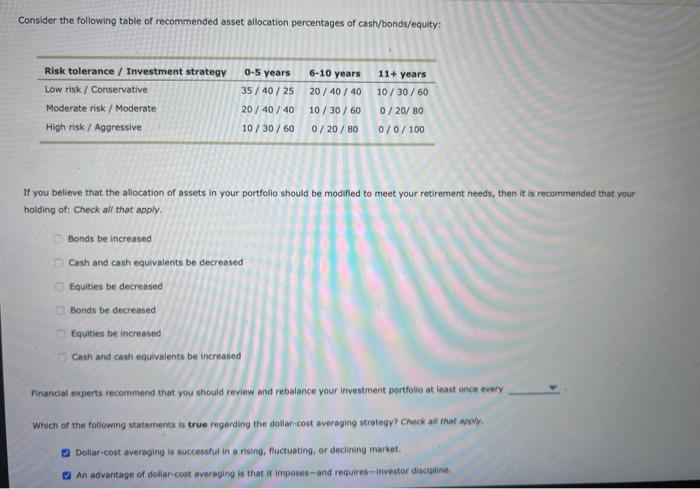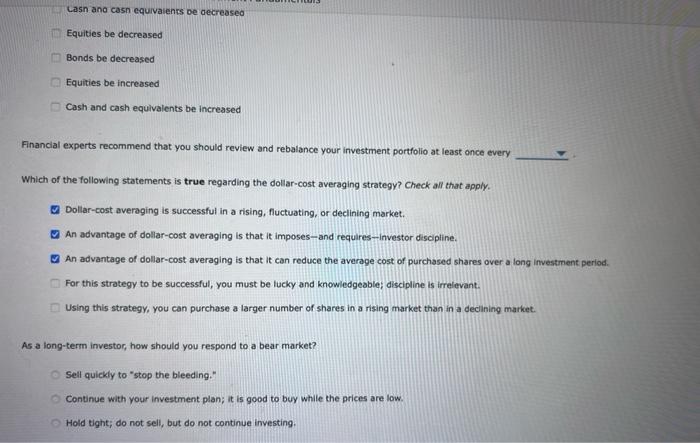Consider the following table of recommended asset allocation percentages of cash/bonds/equity: Risk tolerance / Investment strategy 0-5 years 6-10 years Low risk / Conservative 35/40/25 20 / 40/40 11+ years 10/30/60 0/20/80 Moderate risk / Moderate High risk / Aggressive 20 / 40/40 10/30/60 10/30 / 60 0/20/80 ore 0/0/100 If you believe that the allocation of assets in your portfolio should be modified to meet your retirement needs, then it is recommended that your holding of: Check all that apply. Bonds be increased Cash and cash equivalents be decreased Equities be decreased Bonds be decreased Equities be increased Cash and cash equivalents be increased Financial experts recommend that you should review and rebalance your investment portfolio at least once every which of the following statements is true regarding the dollar-cost averaging strategy? Check that wowy. Dollar-cost averaging is successful in a rising, fluctuating, or declining market An advantage of dollar cost averaging is that it imposes and requires --Investor discipline Casn ang cash equivalents de decreased Equities be decreased Bonds be decreased Equities be increased Cash and cash equivalents be increased Financial experts recommend that you should review and rebalance your investment portfolio at least once every Which of the following statements is true regarding the dollar-cost averaging strategy? Check all that apply. Dollar-cost averaging is successful in a rising, Muctuating, or declining market. An advantage of dollar-cost averaging is that it imposes and requires-Investor discipline. An advantage of dollar-cost averaging is that it can reduce the average cost of purchased shares over a long investment period. For this strategy to be successful, you must be lucky and knowledgeable; discipline is irrelevant. Using this strategy, you can purchase a larger number of shares in a rising market than in a declining market. As a long-term investor, how should you respond to a bear market? Sell quickly to stop the bleeding." Continue with your investment plan; it is good to buy while the prices are low. Hold tight; do not sell, but do not continue investing. Consider the following table of recommended asset allocation percentages of cash/bonds/equity: Risk tolerance / Investment strategy 0-5 years 6-10 years Low risk / Conservative 35/40/25 20 / 40/40 11+ years 10/30/60 0/20/80 Moderate risk / Moderate High risk / Aggressive 20 / 40/40 10/30/60 10/30 / 60 0/20/80 ore 0/0/100 If you believe that the allocation of assets in your portfolio should be modified to meet your retirement needs, then it is recommended that your holding of: Check all that apply. Bonds be increased Cash and cash equivalents be decreased Equities be decreased Bonds be decreased Equities be increased Cash and cash equivalents be increased Financial experts recommend that you should review and rebalance your investment portfolio at least once every which of the following statements is true regarding the dollar-cost averaging strategy? Check that wowy. Dollar-cost averaging is successful in a rising, fluctuating, or declining market An advantage of dollar cost averaging is that it imposes and requires --Investor discipline Casn ang cash equivalents de decreased Equities be decreased Bonds be decreased Equities be increased Cash and cash equivalents be increased Financial experts recommend that you should review and rebalance your investment portfolio at least once every Which of the following statements is true regarding the dollar-cost averaging strategy? Check all that apply. Dollar-cost averaging is successful in a rising, Muctuating, or declining market. An advantage of dollar-cost averaging is that it imposes and requires-Investor discipline. An advantage of dollar-cost averaging is that it can reduce the average cost of purchased shares over a long investment period. For this strategy to be successful, you must be lucky and knowledgeable; discipline is irrelevant. Using this strategy, you can purchase a larger number of shares in a rising market than in a declining market. As a long-term investor, how should you respond to a bear market? Sell quickly to stop the bleeding." Continue with your investment plan; it is good to buy while the prices are low. Hold tight; do not sell, but do not continue investing








